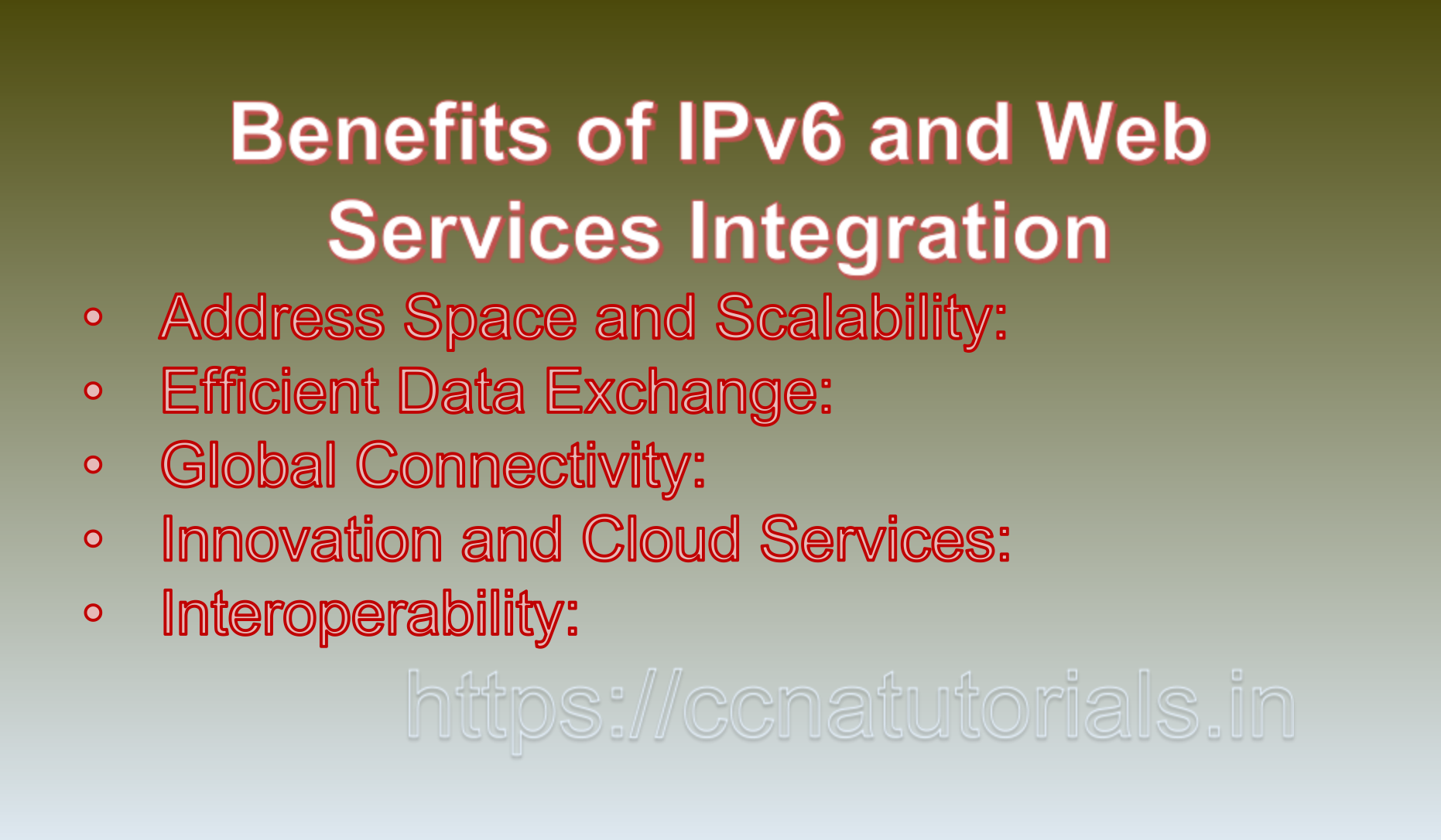Contents of this article
In this article, I describe IPv6 and Web Services: Enabling Seamless Connectivity and Innovation in the Digital World. In the realm of modern networking, the integration of IPv6 (Internet Protocol version 6) and web service has transformed the way we interact with digital content and applications over the internet. This powerful combination facilitates efficient data exchange, supports the growth of cloud computing, and opens doors to innovative services. In this article, we’ll delve into the symbiotic relationship between IPv6 and web services, their advantages, implementation considerations, and provide examples to illustrate their significance in the digital landscape.
Understanding IPv6 and Web Service: An Overview
IPv6: IPv6 is the successor to IPv4, designed to overcome the limitations of the older protocol. Its primary enhancement lies in the significantly larger address space, which accommodates the growing number of devices and facilitates seamless communication across the internet.
Web Services: Web services are software components that allow applications to communicate and share data over the internet. They enable interoperability between different systems and platforms, making it possible for diverse applications to work together.
Benefits of IPv6 and Web Service Integration
1. Address Space and Scalability:
IPv6’s expansive address space ensures that web services can connect and communicate with an increasing number of devices, supporting the growth of IoT and interconnected systems.
2. Efficient Data Exchange:
IPv6’s improved routing and addressing mechanisms contribute to faster and more efficient data exchange between web services, resulting in improved response times and reduced latency.
3. Global Connectivity:
IPv6’s address space enables seamless global connectivity, ensuring that web services can be accessed from anywhere in the world without address exhaustion issues.
4. Innovation and Cloud Services:
The integration of IPv6 and web services supports the development and deployment of innovative cloud-based services and applications, fostering digital transformation.
5. Interoperability:
Web services can communicate across different platforms and technologies, enhancing interoperability and enabling a diverse range of applications to work together harmoniously.
IPv6 and Web Service Implementation Considerations
1. IPv6 Network Infrastructure:
Organizations providing web services need to ensure their network infrastructure is IPv6-ready to facilitate communication with devices and clients using IPv6 addresses.
2. Web Service APIs:
Web service APIs (Application Programming Interfaces) should be designed to support both IPv4 and IPv6 addresses, allowing clients with different address types to connect seamlessly.
3. Security Measures:
Security mechanisms, including encryption, authentication, and authorization, must be implemented to protect data exchanged between web services over IPv6 networks.
Examples Illustrating IPv6 and Web Services Integration
1. Cloud Computing and IPv6:
Consider a cloud service provider offering storage and computation resources to clients globally. By integrating IPv6 and web services:
– Clients from various regions can access cloud resources using IPv6 addresses, ensuring smooth connectivity and eliminating address exhaustion concerns.
– Web services supporting cloud-based applications can seamlessly communicate using IPv6, enhancing data exchange and user experience.
2. IoT and Smart Devices:
In the context of IoT, imagine a home automation system where various smart devices communicate with each other. Integrating IPv6 and web services:
– Smart devices, each assigned a unique IPv6 address, can communicate efficiently using web services, enabling remote control and automation.
– A web service API facilitates interaction between a user’s smartphone (connected via IPv6) and the smart devices, allowing the user to control devices remotely.
3. E-Commerce and Web Services:
In an e-commerce scenario, the integration of IPv6 and web services enhances the customer experience:
– IPv6-enabled devices can access e-commerce websites seamlessly, even during high traffic periods, thanks to efficient IPv6 routing.
– Web service APIs enable secure and real-time communication between the e-commerce platform and payment gateways, ensuring smooth transactions.
Short description of IPv6 and Web Services
The fusion of IPv6 and web services has brought about a paradigm shift in how we exchange data, collaborate, and innovate in the digital era. IPv6’s expansive address space, efficient routing, and enhanced connectivity complement the capabilities of web services, enabling seamless communication and interaction across platforms and devices. As organizations continue to embrace digital transformation and develop cloud-based, IoT, and e-commerce solutions, the integration of IPv6 and web services remains a cornerstone for building robust, scalable, and interoperable systems that drive innovation and improve user experiences on a global scale.

IPv6 and Web Services: Enabling Seamless and Scalable Online Experiences
In the digital age, web services have become the backbone of modern applications, offering a wide range of functionalities and interactions over the internet. The integration of IPv6 (Internet Protocol version 6) with web services is a significant advancement that enhances the efficiency, scalability, and global reach of these services. This combination offers benefits such as increased address space, improved connectivity, and better support for IoT devices. In this article, we’ll explore the intersection of IPv6 and web services, the advantages they bring, implementation considerations, and provide examples to illustrate their importance in the digital landscape.
Understanding IPv6 and Web Services: An Overview
IPv6: IPv6 is the successor to IPv4, designed to overcome the limitations of the older protocol by offering a significantly larger address space and improved features. With the proliferation of devices and the growth of the internet, IPv6 ensures that there are ample unique IP addresses to accommodate the increasing number of connected devices.
Web Services: Web services are software components that allow applications to communicate and interact over the internet. They enable different systems, often developed using different programming languages or platforms, to exchange data and functionality seamlessly.
Benefits of IPv6 and Web Services Integration
1. Increased Address Space:
IPv6’s expansive address space ensures that web services can be assigned unique IP addresses, facilitating efficient communication between services and devices.
2. Global Connectivity:
IPv6’s larger address pool enhances the global scalability of web services, enabling seamless access and interaction from users and devices worldwide.
3. IoT Integration:
As the Internet of Things (IoT) continues to expand, IPv6’s abundant address space accommodates the growing number of IoT devices that require internet connectivity.
4. End-to-End Communication:
IPv6’s design promotes end-to-end communication, reducing the need for complex network address translation (NAT) setups and enabling direct interaction between devices.
5. Mobile Compatibility:
IPv6’s mobile-friendly architecture ensures that web services can be easily accessed and utilized by mobile devices, catering to the increasing use of smartphones and tablets.
IPv6 and Web Services Implementation Considerations
1. Infrastructure Compatibility:
Organizations providing web services need to ensure that their network infrastructure supports IPv6 to offer uninterrupted access to users with IPv6-enabled devices.
2. Application Development:
Developers must ensure that web services are IPv6-compatible, allowing seamless interaction for users and devices utilizing IPv6 connections.
3. Security Measures:
IPv6-enabled web services should implement security measures to protect against potential vulnerabilities and threats, just as in IPv4-based services.
Examples Illustrating IPv6 and Web Services Integration
1. Cloud-Based Storage:
Consider a cloud storage provider that offers file storage and sharing services to users. By integrating IPv6:
– Users with IPv6-enabled devices experience faster and more reliable access to their stored files.
– Scalability is improved, enabling the provider to accommodate a larger user base and increasing storage demands.
– IoT devices with IPv6 connections can seamlessly upload and retrieve files from the cloud storage service.
2. E-Commerce Platform:
An e-commerce platform offers online shopping and payment services to customers worldwide. With IPv6 integration:
– Customers from different regions can access the platform using IPv6 connections, ensuring global reach.
– Transactions can be conducted more efficiently, as IPv6’s improved routing reduces latency and enhances the responsiveness of the platform.
– Mobile users with IPv6-enabled devices can enjoy seamless browsing and shopping experiences.
3. Social Media Network:
A social media network connects users through posts, messages, and interactions. By leveraging IPv6:
– Users across the globe can connect to the network using IPv6 connections, supporting the network’s global user base.
– Media files, such as images and videos, can be delivered faster and more efficiently to users’ feeds and profiles.
– IoT devices, integrated into users’ lifestyles, can engage with the social media network via IPv6 connections.
Conclusion for IPv6 and Web Services
The integration of IPv6 with web service brings forth a myriad of benefits, enhancing the efficiency, scalability, and global reach of these essential digital functionalities. As web service continue to be the cornerstone of modern applications, the adoption of IPv6 ensures seamless interactions, improved performance, and the ability to cater to the evolving needs of a connected world. IPv6’s increased address space, mobile compatibility, and IoT support enable organizations to deliver robust and effective web services that cater to users and devices across the globe. As the digital landscape evolves, the synergy between IPv6 and web service will play a pivotal role in shaping the future of online experiences. I hope you found this article helpful, you may drop a comment below or contact us for any king of query related to this article.






